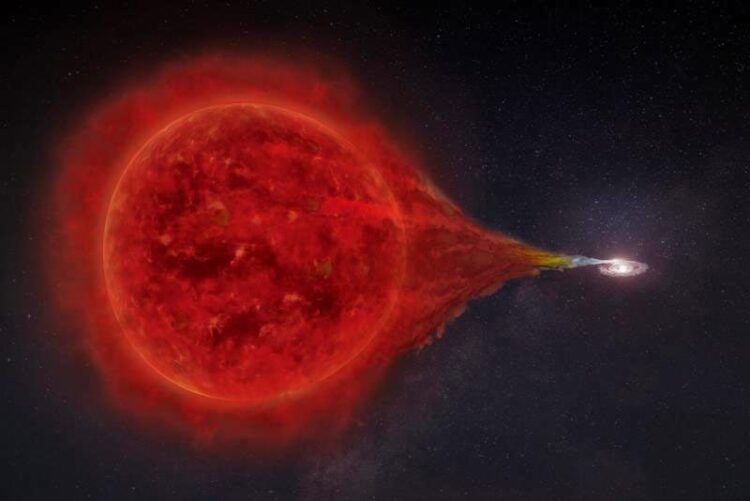MAGIC telescopes observe nova explosion

Artwork of the binary star system RS Ophiuchi: Matter flows from the red giant onto the white dwarf. The newly added stellar envelopes explode in a bright nova about every 15 years.
Credit: superbossa.com/MPP
Nova outbursts are apparently a source for cosmic rays.
Light on, light off – this is how one could describe the behavior of the nova, which goes by the name RS Ophiuchi (RS Oph). Every 15 years or so, a dramatic explosion occurs in the constellation of the Serpent Bearer. Birthplaces of a nova are systems in which two very different stars live in a parasitic relationship: A white dwarf, a small, burned-out and tremendously dense star – a teaspoon of its matter weighs about 1 ton – orbits a red giant, an old star that will soon burn up.
The dying giant star feeds the white dwarf with matter shedding its outer hydrogen layer as the gas flows onto the nearby white dwarf. This flow of matter continues, until the white dwarf over(h)eats itself. The temperature and pressure in the newly gained stellar shells become too large and are flung away in a gigantic thermonuclear explosion. The dwarf star remains intact and the cycle begins again – until the spectacle repeats itself.
Explosion in the high-energy range
It had been speculated that such explosions involve high energies. The two MAGIC telescopes recorded gamma rays with the value of 250 gigaelectronvolts (GeV), among the highest energies ever measured in a nova. By comparison, the radiation is a hundred billion times more energetic than visible light.
MAGIC was able to make its observations following initial alerts from other instruments measuring at different wavelengths. “The spectacular eruption of the RS Ophiuchi shows that the MAGIC telescopes’ fast response really pays off: It takes them no more than 30 seconds to move to a new target,” said David Green, a scientist at the Max Planck Institute for Physics and one of the authors of the paper.
Accelerated protons as a part of cosmic rays
After the explosion, several shock fronts propagated through the stellar wind from the Red Giant and the interstellar medium surrounding the binary system. These shock waves work like a giant power plant in which particles are accelerated to near the speed of light. The combined measurements suggest that the gamma rays emanate from energetic protons, nuclei of hydrogen atoms.
“This also makes nova outbursts a source of cosmic rays,” explains David Green. “However, they tend to play the role of local heroes – meaning to only contribute to the cosmic rays in the close neighborhood. The big players for cosmic rays are supernova remnants. The shock fronts created from stellar explosions are far more violent compared to novae.
To fully understand the complicated interplay of violent events with the interstellar medium in the Milky Way, more observations like those reported now will be necessary. The MAGIC collaboration will therefore continue to look for “restless” objects in our Galaxy and beyond.
Journal: Nature Astronomy
DOI: 10.1038/s41550-022-01640-z
Method of Research: Observational study
Subject of Research: Not applicable
Article Title: Proton acceleration in thermonuclear nova explosions revealed by gamma rays
Article Publication Date: 14-Apr-2022
Media Contact
All latest news from the category: Physics and Astronomy
This area deals with the fundamental laws and building blocks of nature and how they interact, the properties and the behavior of matter, and research into space and time and their structures.
innovations-report provides in-depth reports and articles on subjects such as astrophysics, laser technologies, nuclear, quantum, particle and solid-state physics, nanotechnologies, planetary research and findings (Mars, Venus) and developments related to the Hubble Telescope.
Newest articles

Trotting robots reveal emergence of animal gait transitions
A four-legged robot trained with machine learning by EPFL researchers has learned to avoid falls by spontaneously switching between walking, trotting, and pronking – a milestone for roboticists as well…

Innovation promises to prevent power pole-top fires
Engineers in Australia have found a new way to make power-pole insulators resistant to fire and electrical sparking, promising to prevent dangerous pole-top fires and reduce blackouts. Pole-top fires pose…

Possible alternative to antibiotics produced by bacteria
Antibacterial substance from staphylococci discovered with new mechanism of action against natural competitors. Many bacteria produce substances to gain an advantage over competitors in their highly competitive natural environment. Researchers…





















